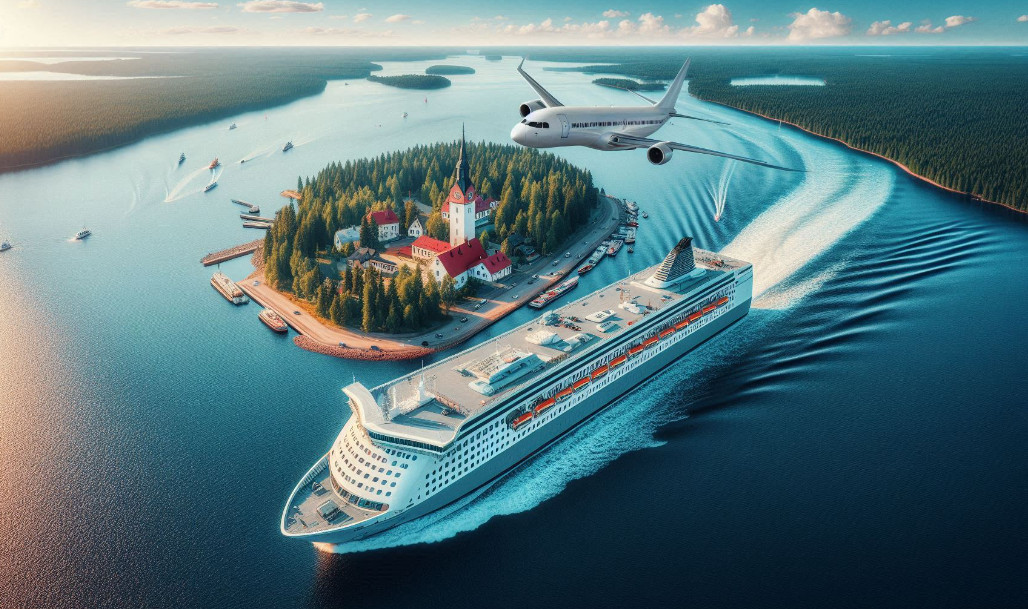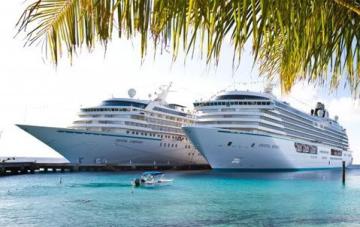 Deciding how to travel to Finland can be a delightful dilemma. Whether you choose to glide over the waves on a ferry or soar through the skies on a plane, each mode of transportation offers its own unique set of experiences and advantages. This article explores the key factors to consider when making your choice, ensuring your journey to the Land of a Thousand Lakes is as enjoyable as possible.
Deciding how to travel to Finland can be a delightful dilemma. Whether you choose to glide over the waves on a ferry or soar through the skies on a plane, each mode of transportation offers its own unique set of experiences and advantages. This article explores the key factors to consider when making your choice, ensuring your journey to the Land of a Thousand Lakes is as enjoyable as possible.
Convenience and Speed are often the primary considerations for travelers. Flying is undoubtedly the fastest way to reach Finland, with direct flights from major cities around the world. In a matter of hours, you can find yourself landing in Helsinki, ready to start your adventure. However, taking a ferry can transform your journey into a leisurely, scenic voyage, allowing you to savor the trip itself as part of your travel experience.
Cost is another crucial factor. While budget airlines often offer competitive fares, the total cost of flying can quickly add up with additional expenses like luggage fees, airport transfers, and in-flight meals. Ferries, on the other hand, often provide all-inclusive pricing, with meals and entertainment included in the ticket. Additionally, traveling by ferry can be more economical for those bringing a vehicle, as it eliminates the need for rental cars upon arrival.
Lastly, consider the experience you seek. A flight is efficient and straightforward, but it can be quite impersonal and routine. A ferry journey offers a more relaxed pace, with opportunities to enjoy onboard amenities such as restaurants, shops, and panoramic decks. It’s an excellent choice for those who value the journey as much as the destination, providing a chance to unwind and appreciate the scenic beauty of the Baltic Sea.
In conclusion, both ferries and planes have their merits when traveling to Finland. Your choice ultimately depends on your priorities–be it speed, cost, or the overall travel experience. Whichever you choose, Finland awaits with its breathtaking landscapes, rich culture, and warm hospitality.
Ferry vs Plane: Pros and Cons
Ferry
Traveling to Finland by ferry offers a unique and leisurely experience. Here are some pros and cons to consider:
-
Pros:
- Scenic Views: Enjoy beautiful sea views and the chance to spot marine wildlife.
- Relaxed Atmosphere: Ferries provide a more laid-back travel environment compared to the hustle and bustle of airports.
- Spaciousness: More room to move around, stretch your legs, and access various amenities on board like restaurants and shops.
- Luggage Flexibility: Generally, ferries have more lenient luggage policies, allowing you to bring more without extra fees.
-
Cons:
- Travel Time: Ferries are significantly slower than planes, which might not be ideal for those on a tight schedule.
- Weather Dependence: Ferry schedules and comfort can be affected by bad weather, potentially leading to delays or cancellations.
- Limited Routes: Ferries only operate between specific ports, which may require additional travel arrangements to reach your final destination.
Plane
Flying to Finland is a fast and efficient mode of travel. Here are the advantages and disadvantages:
-
Pros:
- Speed: Air travel is the fastest way to reach Finland, often taking just a few hours.
- Frequency: More frequent flights and a wider range of departure times provide greater flexibility in planning your trip.
- Accessibility: Airports are widely accessible with connections from various cities, making it easier to plan your journey.
- Weather Resilience: Modern aircraft are less affected by weather conditions, ensuring more reliable schedules.
-
Cons:
- Cost: Plane tickets can be more expensive, especially when booking last minute or during peak seasons.
- Security and Procedures: Extensive security checks and boarding procedures can add time and stress to your travel experience.
- Luggage Restrictions: Stricter luggage policies often mean higher fees for extra or overweight bags.
- Limited Space: Less legroom and personal space compared to ferries, which can be uncomfortable on longer flights.

Travel Experience Comparison
Choosing between a ferry and a plane for your trip to Finland can significantly affect your travel experience. Both modes of transportation offer distinct advantages and cater to different preferences. Here’s a comparison to help you decide which suits your travel style best.
Comfort and Amenities
When it comes to comfort and amenities, ferries and planes offer vastly different experiences:
- Ferry: Ferries often provide a more leisurely and spacious travel experience. You can walk around, enjoy onboard entertainment, dine at various restaurants, and even book a private cabin for rest. Ferries are ideal for those who enjoy a more relaxed journey with scenic views of the sea.
- Plane: Air travel is faster but typically offers less space and fewer amenities. While airlines may provide in-flight entertainment, meals, and beverages, the confined space can be less comfortable, especially for longer flights. Planes are suited for those prioritizing speed and efficiency over comfort.
Scenery and Sightseeing
The opportunity for sightseeing and enjoying the journey is another important factor:
- Ferry: A ferry ride offers beautiful sea views and the chance to see coastal landscapes and islands. Passengers can spend time on deck, soaking in the fresh air and panoramic vistas. This mode of travel is perfect for those who enjoy the journey as much as the destination.
- Plane: While planes provide aerial views of landscapes, these are often brief and limited, especially if the flight is at a high altitude or during nighttime. Air travel is more about reaching the destination quickly, with less emphasis on the journey itself.
Overall Experience
- Time: Flights are generally much quicker, ideal for those with tight schedules. Ferries, on the other hand, take longer but can be part of a more relaxed travel itinerary.
- Cost: Depending on the season and availability, ferries can sometimes be more cost-effective, especially when considering luggage fees and additional costs associated with flying.
- Flexibility: Ferries offer more flexibility in terms of movement during the journey, allowing you to stretch your legs and enjoy various activities onboard. Planes offer limited mobility and activities are restricted to your seat area.
In conclusion, the choice between a ferry and a plane for your trip to Finland depends on your priorities. If you value a relaxed, scenic journey with ample amenities, a ferry might be the best option. However, if you prefer a quick and efficient trip, flying would be more suitable. Consider what aspects of travel are most important to you to make the best choice for your trip.

Δημοφιλή άρθρα
Cost Analysis: Ferry or Airfare?
When planning a trip to Finland, one of the crucial factors to consider is the cost of transportation. Comparing the expenses between taking a ferry and flying can help travelers make an informed decision that fits their budget. Below, we break down the costs associated with each option to provide a clearer picture.
Ferry Costs
- Ticket Prices: Ferry tickets can range from €50 to €150 per person, depending on the class of service, time of year, and any promotions available.
- Cabin Accommodations: For overnight trips, cabins are an additional cost, typically ranging from €50 to €200 based on size and amenities.
- Meals: Onboard dining can be expensive, with meals ranging from €10 for a simple snack to €50 for a full dinner.
- Vehicle Transport: If you plan to bring a car, expect to pay an extra €100 to €300, depending on the vehicle size.
Airfare Costs
- Ticket Prices: Flights to Finland can vary significantly, with prices generally between €70 and €300, influenced by the airline, season, and how far in advance tickets are purchased.
- Luggage Fees: Budget airlines often charge extra for checked baggage, typically around €20 to €50 per bag.
- Airport Transfers: Transportation to and from the airport can add another €20 to €50, depending on the distance and mode of travel.
- Additional Charges: Other potential costs include seat selection fees, onboard meals, and extra charges for booking with a credit card, which can add up to €20 to €50.
Comparative Summary
- Base Ticket Costs: Ferries and flights have comparable base ticket prices, though flights can often be cheaper if booked well in advance.
- Additional Costs: Ferries may incur higher additional costs, especially with cabin accommodations and vehicle transport, whereas flights often have lower but more numerous extra charges.
- Total Expenses: For budget travelers, flights may offer a more economical option when considering all factors, while ferries might be preferred for those valuing comfort and the ability to bring a vehicle.
Ultimately, the choice between ferry and plane for a trip to Finland depends on individual preferences and budget constraints. By evaluating the detailed cost components, travelers can better plan their journey and ensure a cost-effective and enjoyable trip.
Comfort and Convenience: Air vs Sea
When deciding between a ferry and a plane for your trip to Finland, comfort and convenience are crucial factors to consider. Both modes of transportation offer unique advantages and potential drawbacks depending on your travel preferences and needs.
Comfort on a Ferry
Ferries provide a spacious and relaxing environment, ideal for those who appreciate a leisurely journey. Passengers can move around freely, enjoy onboard amenities such as restaurants, bars, and shops, and even book private cabins for added comfort. The gentle sway of the ferry and the scenic sea views contribute to a serene travel experience, making it a suitable choice for travelers who enjoy taking their time and savoring the journey.
Convenience of Air Travel
Flying to Finland offers unparalleled speed and efficiency, especially for those with tight schedules. Airports typically have extensive facilities, including lounges, dining options, and shopping, ensuring travelers are well catered to before their flight. The main advantage of air travel is the significantly shorter travel time, allowing you to maximize your time at the destination. Additionally, for long-distance travelers, planes provide direct routes that are often not available by ferry.
In conclusion, choosing between a ferry and a plane for your trip to Finland depends on your priorities. If you value a relaxed journey with ample space and amenities, the ferry might be your preferred option. On the other hand, if speed and efficiency are paramount, air travel will get you to your destination quickly and comfortably.

Onboard Amenities and Services
Whether you choose to travel by ferry or plane to Finland, the amenities and services offered onboard play a crucial role in enhancing your travel experience. Here’s a comparison of what you can expect:
Ferry
- Spacious cabins with various accommodation options, from economy to deluxe suites.
- Restaurants and cafes serving a variety of Finnish and international cuisine.
- Bars and lounges offering drinks, cocktails, and scenic views of the Baltic Sea.
- Shopping opportunities with duty-free shops selling a range of products.
- Entertainment options such as cinemas, live music, and sometimes even spas and saunas.
- Children’s play areas to keep young travelers entertained.
Plane
- Comfortable seating with options for extra legroom and premium classes.
- Meals and snacks served during the flight, often featuring Finnish specialties.
- Beverage service including alcoholic and non-alcoholic drinks.
- Personal entertainment systems with a selection of movies, TV shows, and music.
- Wi-Fi connectivity (available on some flights) for staying connected throughout the journey.
- Assistance for passengers with special needs or requirements.
Both options provide essential amenities to ensure a pleasant journey, but the choice ultimately depends on your preferences for comfort, style of travel, and the experience you seek on your way to Finland.






